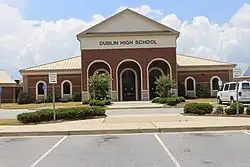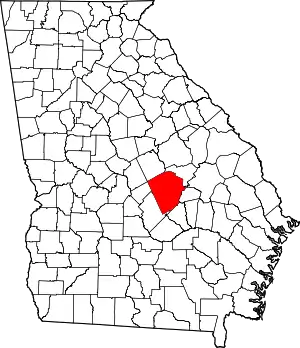Dublin, Georgia
Dublin (Irish: Baile Átha Cliath) is a city and county seat of Laurens County, Georgia, United States. As of the 2020 census, the city had a population of 16,074. [4]
Dublin, Georgia | |
|---|---|
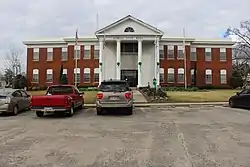 Dublin City Hall | |
| Nickname: The Emerald City | |
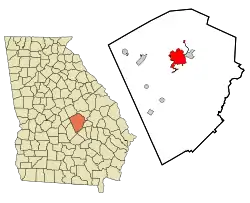 Location in Laurens County and the state of Georgia | |
| Coordinates: 32°32′15″N 82°55′6″W | |
| Country | United States |
| State | Georgia |
| County | Laurens |
| Government | |
| • Mayor | Joshua Kight |
| • City Manager | Josh Powell (interim) |
| Area | |
| • Total | 16.06 sq mi (41.59 km2) |
| • Land | 15.96 sq mi (41.35 km2) |
| • Water | 0.09 sq mi (0.24 km2) |
| Elevation | 223 ft (68 m) |
| Population (2020) | |
| • Total | 16,074 |
| • Density | 1,006.89/sq mi (388.76/km2) |
| Time zone | UTC-5 (EST) |
| • Summer (DST) | UTC-4 (EDT) |
| ZIP codes | 31021, 31027, 31040 |
| Area code | 478 |
| FIPS code | 13-24376[3] |
| GNIS feature ID | 0313692[2] |
| Website | www |
History
The original settlement was named after Dublin, Ireland.[5]
.jpg.webp)
Dublin, according to a historical marker[6] at the town's main Oconee River bridge, was one of the last encampments at which Confederate President Jefferson Davis and his family stayed before being captured by Union forces in May 1865.
In the Dublin riot of July 1919 there were a series of violent racial riots between white and black members of the community. These were part of a larger series of racial violence during the 1919 Red Summer.
On April 17, 1944, Martin Luther King Jr. gave his first public speech, "The Negro and the Constitution" at First African Baptist Church in Dublin.[7]
Geography
Dublin is located in north-central Laurens County. The town, named such because the Middle Georgia Piedmont reminded Irish settlers of terrain in their native country, was founded on the Oconee River, which starts in the foothills of the Blue Ridge Mountains in northern Georgia before combining with the Ocmulgee River to form the Altamaha, a river which then proceeds to its mouth on the Atlantic Ocean. The Oconee forms the eastern boundary of Dublin, separating it from the city of East Dublin.
According to the United States Census Bureau, the town has a total area of 16.0 square miles (41.5 km2), of which 15.9 square miles (41.2 km2) are land and 0.09 square miles (0.24 km2), or 0.59%, are water.[8]
Location
The city is located in the central part of the state along Interstate 16. Access to the city can be found from exits 49, 51, 54, and 58. Via I-16, Savannah is 117 miles (188 km) east, and Macon is 53 miles (85 km) northwest. US routes 80, 319, and 441 also run through the city. US 441 connects the city to Milledgeville, 47 miles (76 km) northwest, and McRae–Helena, 35 miles (56 km) south. Numerous state and local highways also run through the city.
Historic districts
Dublin has two historic districts designated by the National Register of Historic Places: the Dublin Commercial Historic District and the Stubbs Park–Stonewall Street Historic District.[9] The Dublin Commercial Historic District consists of the original downtown commercial core, including the earliest extant building in the district: the Hicks Building, dating to 1893. The historic district contains 78 contributing properties, including the Dublin Carnegie Library[10] First National Bank Building,[11] and the former United States Post Office building.[12] Structures within the district represent a wide range of architectural styles, including Colonial Revival, Neoclassical, Commercial, and Art Deco.[13]
The Stubbs Park-Stonewall Street Historic District is located west of Dublin's central business district. The district contains 470 contributing properties, most of which are residential homes constructed between the late 1910s to the early 1940s. The predominant architectural styles of the area consist of Craftsman, Gothic Revival, Folk Victorian, and Georgian Cottage. In addition to historic residences, the district contains properties including historic churches, historic cemeteries, and Dublin's first public park, Stubbs Park.[14]
Climate
| Climate data for Dublin, Georgia, 1991–2020 normals, extremes 1892–present | |||||||||||||
|---|---|---|---|---|---|---|---|---|---|---|---|---|---|
| Month | Jan | Feb | Mar | Apr | May | Jun | Jul | Aug | Sep | Oct | Nov | Dec | Year |
| Record high °F (°C) | 85 (29) |
85 (29) |
92 (33) |
99 (37) |
102 (39) |
108 (42) |
109 (43) |
109 (43) |
108 (42) |
102 (39) |
92 (33) |
88 (31) |
109 (43) |
| Mean maximum °F (°C) | 74.9 (23.8) |
78.3 (25.7) |
83.8 (28.8) |
88.7 (31.5) |
94.4 (34.7) |
97.8 (36.6) |
99.9 (37.7) |
98.7 (37.1) |
95.3 (35.2) |
89.0 (31.7) |
83.1 (28.4) |
76.9 (24.9) |
100.4 (38.0) |
| Average high °F (°C) | 58.3 (14.6) |
62.0 (16.7) |
70.7 (21.5) |
78.3 (25.7) |
85.6 (29.8) |
90.7 (32.6) |
94.0 (34.4) |
92.2 (33.4) |
87.0 (30.6) |
77.9 (25.5) |
68.5 (20.3) |
60.6 (15.9) |
77.1 (25.1) |
| Daily mean °F (°C) | 46.7 (8.2) |
50.0 (10.0) |
57.3 (14.1) |
64.5 (18.1) |
72.5 (22.5) |
79.2 (26.2) |
82.5 (28.1) |
81.3 (27.4) |
75.7 (24.3) |
65.4 (18.6) |
55.3 (12.9) |
48.8 (9.3) |
64.9 (18.3) |
| Average low °F (°C) | 35.1 (1.7) |
38.0 (3.3) |
44.0 (6.7) |
50.6 (10.3) |
59.4 (15.2) |
67.7 (19.8) |
71.0 (21.7) |
70.4 (21.3) |
64.4 (18.0) |
52.9 (11.6) |
42.1 (5.6) |
37.0 (2.8) |
52.7 (11.5) |
| Mean minimum °F (°C) | 20.0 (−6.7) |
23.5 (−4.7) |
27.9 (−2.3) |
36.0 (2.2) |
45.9 (7.7) |
58.2 (14.6) |
63.6 (17.6) |
62.8 (17.1) |
51.9 (11.1) |
36.8 (2.7) |
27.1 (−2.7) |
23.4 (−4.8) |
18.1 (−7.7) |
| Record low °F (°C) | 0 (−18) |
9 (−13) |
14 (−10) |
28 (−2) |
38 (3) |
40 (4) |
50 (10) |
52 (11) |
33 (1) |
25 (−4) |
11 (−12) |
5 (−15) |
0 (−18) |
| Average precipitation inches (mm) | 4.38 (111) |
4.14 (105) |
4.58 (116) |
2.75 (70) |
2.62 (67) |
5.25 (133) |
4.50 (114) |
4.81 (122) |
3.58 (91) |
3.15 (80) |
3.08 (78) |
4.43 (113) |
47.27 (1,200) |
| Average precipitation days (≥ 0.01 in) | 8.5 | 6.5 | 7.4 | 5.4 | 5.5 | 10.1 | 8.0 | 8.9 | 6.1 | 5.6 | 5.5 | 7.0 | 84.5 |
| Source 1: NOAA[15] | |||||||||||||
| Source 2: XMACIS2/NWS[16][17] | |||||||||||||
Demographics
| Census | Pop. | Note | %± |
|---|---|---|---|
| 1880 | 574 | — | |
| 1890 | 862 | 50.2% | |
| 1900 | 2,987 | 246.5% | |
| 1910 | 5,795 | 94.0% | |
| 1920 | 7,707 | 33.0% | |
| 1930 | 6,681 | −13.3% | |
| 1940 | 7,814 | 17.0% | |
| 1950 | 10,232 | 30.9% | |
| 1960 | 13,814 | 35.0% | |
| 1970 | 15,143 | 9.6% | |
| 1980 | 16,083 | 6.2% | |
| 1990 | 16,312 | 1.4% | |
| 2000 | 15,857 | −2.8% | |
| 2010 | 16,201 | 2.2% | |
| 2020 | 16,074 | −0.8% | |
| U.S. Decennial Census[18] | |||
2020 census
| Race | Num. | Perc. | |
|---|---|---|---|
| Black or African American (non-Hispanic) | 9,811 | 61.04% | |
| White (non-Hispanic) | 5,144 | 32.0% | |
| Native American | 23 | 0.14% | |
| Asian | 342 | 2.13% | |
| Pacific Islander | 1 | 0.01% | |
| Other/Mixed | 421 | 2.62% | |
| Hispanic or Latino | 332 | 2.07% |
As of the 2020 United States census, there were 16,074 people, 5,520 households, and 3,336 families residing in the city.
2000 census
As of the census[3] of 2000, there were 15,857 people, 6,130 households, and 4,027 families residing in the city. The population density was 1,200.7 inhabitants per square mile (463.6/km2). There were 6,977 housing units at an average density of 528.3 per square mile (204.0/km2). The racial makeup of the city was 51.42% African American, 45.54% White, 0.20% Native American, 1.75% Asian, 0.04% Pacific Islander, 0.29% from other races, and 0.76% from two or more races. Hispanic or Latino of any race were 1.14% of the population.
There were 6,130 households, out of which 31.1% had children under the age of 18 living with them, 39.2% were married couples living together, 23.2% had a female householder with no husband present, and 34.3% were non-families. 31.1% of all households were made up of individuals, and 12.7% had someone living alone who was 65 years of age or older. The average household size was 2.44 and the average family size was 3.05.
In the city, the population was spread out, with 26.7% under the age of 18, 9.0% from 18 to 24, 24.8% from 25 to 44, 22.2% from 45 to 64, and 17.2% who were 65 years of age or older. The median age was 37 years. For every 100 females, there were 85.7 males. For every 100 females age 18 and over, there were 80.2 males.
The median income for a household in the city was $28,532, and the median income for a family was $36,463. Males had a median income of $30,830 versus $21,553 for females. The per capita income for the city was $16,560. About 22.5% of families and 27.5% of the population were below the poverty line, including 41.1% of those under age 18 and 21.2% of those age 65 or over.
Dublin Micropolitan Statistical Area
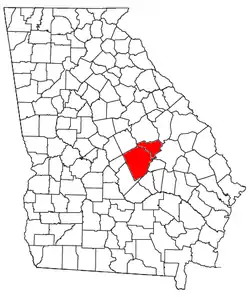
Dublin is the principal city of the Dublin Micropolitan Statistical Area, a micropolitan area that covers Johnson and Laurens counties[20] and had a combined population of 53,434 at the 2000 census.[3]
Government
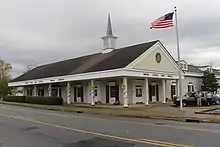
Dublin's city government is made up of a mayor and a city council composed of seven council members. Four of the council members represent wards, or districts, within the city boundaries; the remaining three members are considered council members at large, representing the entire city as legislative members.[21]
Dublin was chosen as a City of Excellence by the Georgia Municipal Association and Georgia Trend magazine in 2000.[22] This distinction recognized Dublin as one of the ten best managed and most livable cities in Georgia when evaluated on areas like public safety, cultural activities, fiscal management, and downtown viability.
In 2005, Dublin was designated as a "Signature Community" by the Georgia Department of Community Affairs.[22] Dublin was also recognized by the American Association of Retirement Communities (AARC) as a Seal of Approval Community in 2009.[23]
The United States Postal Service operates the Dublin Post Office and the Court Square Station in Dublin.[24][25]
The Carl Vinson Veterans Administration Medical Center is located in Dublin.[26] It was originally commissioned as Naval Hospital Dublin on January 22, 1945, as an ideal location for convalescence from rheumatic fever. As such it was the site of the commissioning of Naval Medical Research Unit Four on May 31, 1946, to study the disease. The Navy transferred the hospital to the Veterans Affairs Department in November 1947, and it was subsequently named for congressman Carl Vinson who was responsible for getting it built in Dublin. Today, the medical center provides a range of services to veterans in Middle and South Georgia, including primary care, mental health, ambulatory and urgent care, optometry, women's health, and extended care. The medical center features a 340 operating-bed facility and has approximately 1,100 employees.[27]
Dublin's Laurens County Library is known for its genealogy department, with archives and records going back two hundred years.
Arts and culture
Theatre Dublin
Theatre Dublin, originally known as the Martin Theater, was constructed in 1934 in Dublin's Historic Downtown Commercial District.[28] The theatre features Art Deco architectural design, with flat symmetrical wall surfacing and horizontal bands, in addition to an overhanging marquee and neon sign.[13]
Since its renovation in 1996, Theatre Dublin has served as a performing arts center for Dublin-Laurens County and surrounding areas. The theatre houses a regular variety of events and performances, including musical artists, plays and performances, orchestras, concerts, and showings of both classical and contemporary films.
Dublin Carnegie Library
The Dublin Carnegie Library was built in 1904 by a grant from Andrew Carnegie.[29] It is located in Dublin's Historic Downtown Commercial District, and the Dublin Carnegie is one of only three surviving Carnegie Libraries in the state of Georgia listed on the National Register of Historic Places and still in its original form. The Dublin Carnegie served as public library for the region until the 1960s, at which point the city and county constructed a larger public library. In the late 1970s, the Dublin Carnegie Library was structurally stabilized and maintained by the Dublin-Laurens Historical Society.[30] For more than 35 years, the building served as the home of the Dublin-Laurens Museum.[10]
In 2014, the Dublin-Laurens Museum moved to a new location, leaving the Dublin Carnegie Library unoccupied. The Dublin Downtown Development Authority then renovated the building to its historic stature, restoring many of the building's original features. Since the renovation by the DDA in 2014, the Dublin Carnegie has served as an event space and fine arts gallery, featuring local and statewide art displays.[10]
Education
Public schools
The Dublin City School District holds pre-school to grade twelve, and consists of two elementary schools, a middle school, a high school, and an alternative school.[31] The district has approximately 2,400 students as of 2016.[32]
- Hillcrest Elementary School
- Susie Dasher Elementary School
- Dublin Middle School
- Dublin High School
- Moore Street School (Alternative)
The Laurens County School District holds grades pre-school to grade twelve, and serves areas outside of the Dublin city limits.
Private schools
- Trinity Christian School
Higher education
- Georgia Military College - Dublin Campus[33]
- Oconee Fall Line Technical College - South Campus[34]
- Middle Georgia State University - Dublin Campus[35]
Notable events
Festivals
Dublin is known for its St Patrick's festival which takes place annually during March.[36]
Sister city
- Osaki, Miyagi, Japan
Pageants
Dublin is home to several scholarship pageants, which are largely popular in the southern United States:
- The Miss Saint Patrick's Scholarship pageant, sponsored by the Pilot Club, is held every year in March in conjunction with the Saint Patrick's Day celebration.
- Dublin and Laurens County's America's Junior Miss Pageant is a scholarship competition held yearly for high school juniors. The winners of both the Dublin and Laurens County pageants advance to the state pageant. Its new name is Distinguished Young Women.
- The Miss and Outstanding Teen Irish Capital Scholarship Pageant is an official Miss Georgia and Miss America preliminary pageant and is held in the fall. The Miss Irish Capital Pageant is currently on hiatus and will hopefully return soon. Former Miss Irish Capital winners are: Donna Sellers, Carly Floyd, Amanda Rampley and Brittney Griffith. Former Miss Irish Capital Outstanding Teen winners are: Katie Lassiter, Jordan Mason and Katherine Phipps. Tom Lively started the pageant and was the executive director for the first three years until moving to the Atlanta, Georgia, area and was the executive director of the Miss Southern Empire Pageant for two years. Kenn Nix was the last executive director for the Miss Irish Capital Pageant. They hope to return soon.
In literature
Dublin, the Oconee River, and Laurens County are mentioned in the opening page of James Joyce's Finnegans Wake: "nor had topsawyer's rocks by the stream Oconee exaggerated themselves to Laurens County's gorgios while they went doublin their mumper all the time." (Joyce explained in a letter: "Dublin, Laurens Co, Georgia, founded by a Dubliner, Peter Sawyer, on r. Oconee. Its motto: Doubling all the time.")[37]
Notable people
- Jamel Ashley, retired track athlete who competed in the sprint events
- Jermaine Hall, basketball player for Maccabi Ashdod of the Israeli Basketball Premier League
- Matt Hatchett - Businessman and politician. He is a member of the Georgia House of Representatives from the 150th District.[38]
- Eleanor Ison Franklin (1929–1998), medical physiologist and endocrinologist
- Anthony Kewoa Johnson, retired American mixed martial artist who competed in the light heavyweight division of the Ultimate Fighting Championship
- Marcos Knight, professional basketball player
- J. Roy Rowland, congressman from 1983 to 1995 and a resident of Dublin[39]
- Demaryius Thomas, football player in the NFL for the Denver Broncos
- Quincy Trouppe, baseball player in the Negro leagues[40]
- Erik Walden, National Football League player
- Darrell Williams Jr., football player in the NFL for the San Francisco 49ers
- Ron Rogers, retired Football Player at Georgia Tech and in the NFL for the Baltimore Ravens
- Leh Keen, racing driver
References
- "2020 U.S. Gazetteer Files". United States Census Bureau. Retrieved December 18, 2021.
- U.S. Geological Survey Geographic Names Information System: Dublin, Georgia
- "U.S. Census website". United States Census Bureau. Retrieved January 31, 2008.
- "Find a County". National Association of Counties. Archived from the original on July 4, 2012. Retrieved June 7, 2011.
- Gannett, Henry (1905). The Origin of Certain Place Names in the United States. Govt. Print. Off. pp. 109.
- "GeorgiaInfo :: Carl Vinson Institute of Government :: University of Georgia". Cviog.uga.edu. Retrieved March 24, 2013.
- University, © Stanford; Stanford; California 94305 (June 12, 2017). "King delivers "The Negro and the Constitution" at oratorical contest". The Martin Luther King Jr., Research and Education Institute. Retrieved February 22, 2021.
- "U.S. Gazetteer Files: 2019: Places: Georgia". U.S. Census Bureau Geography Division. Retrieved December 9, 2019.
- "National Register of Historic Places : Search Results". Npgallery.nps.gov. Retrieved April 6, 2022.
- "Dublin Carnegie". Dublincarnegie.com. Retrieved April 6, 2022.
- "Success Stories". Dtdublin.com. Retrieved April 6, 2022.
- "The Old Post Office". Oldpostofficedublin.com. Retrieved April 6, 2022.
- "NATIONAL REGISTER OF HISTORIC PLACES : Dublin Commercial Historic District". Npgallery.nps.gov. Retrieved April 6, 2022.
- "NATIONAL REGISTER OF HISTORIC PLACES : Stubbs Park-Stonewall Street Historic District". Npgallery.nps.gov. Retrieved April 6, 2022.
- "NOAA NCEI U.S. Climate Normals Quick Access". NOAA. Retrieved November 30, 2022.
- "NOAA Online Weather Data – NWS Atlanta". National Weather Service. Retrieved February 23, 2023.
- "xmACIS2". National Oceanic and Atmospheric Administration. Retrieved February 23, 2023.
- "Census of Population and Housing". Census.gov. Retrieved June 4, 2015.
- "Explore Census Data". Data.census.gov. Retrieved December 18, 2021.
- MICROPOLITAN STATISTICAL AREAS AND COMPONENTS Archived June 29, 2007, at the Wayback Machine, Office of Management and Budget, May 11, 2007. Retrieved 2008-07-27.
- "Municode Library". Library.municode.com. Retrieved April 6, 2022.
- "Dublin-Laurens County | Living Here | Awards & Recognition". August 28, 2016. Archived from the original on August 28, 2016. Retrieved April 6, 2022.
- "Downtown Redevelopment and Retiree Attraction: Good Timing". www.gmanet.com. Archived from the original on March 27, 2018. Retrieved June 6, 2022.
- "Post Office Location - DUBLIN Archived June 16, 2012, at the Wayback Machine." United States Postal Service. Retrieved on September 7, 2010
- "
- "VA Dublin Health Care | Veterans Affairs". Dublin.va.gov. Retrieved April 4, 2022.
- "Carl Vinson VA Medical Center - Locations". Va.gov. Retrieved April 6, 2022.
- "Theatre Dublin". Theatredublinga.com. March 26, 2022. Retrieved April 4, 2022.
- "Dublin Carnegie". Dublin Carnegie. November 7, 1904. Retrieved April 4, 2022.
- "Laurens County Historical Society". Laurenshistory.org. Archived from the original on November 9, 2010. Retrieved April 4, 2022.
{{cite web}}: CS1 maint: unfit URL (link) - "Home - Dublin City Schools". Dublincityschools.us. Retrieved April 6, 2022.
- https://app3.doe.k12.ga.us/ows-bin/owa/fin_pack_revenue.display_proc
- "Dublin". Gmc.edu. Retrieved April 6, 2022.
- "Home". Oftc.edu. Retrieved April 6, 2022.
- "Middle Georgia State University". Mga.edu. Retrieved April 6, 2022.
- "Dublin St. Patrick's Festival". Dublin St. Patrick's Festival. Retrieved April 6, 2022.
- "The James Joyce Society: Archive for 2001". Joycesociety.org. Archived from the original on February 17, 2013. Retrieved March 24, 2013.
- "Matt Hatchett's Biography". Vote Smart. Retrieved March 11, 2021.
- Michael Barone and Grant Ujifusa (1987). The Almanac of American Politics 1988. p. 306.
{{cite book}}:|work=ignored (help)CS1 maint: location missing publisher (link) - "Negro Leagues Baseball eMuseum: Personal Profiles: Quincy Trouppe". Nlbemuseum.com. Retrieved August 21, 2020.
